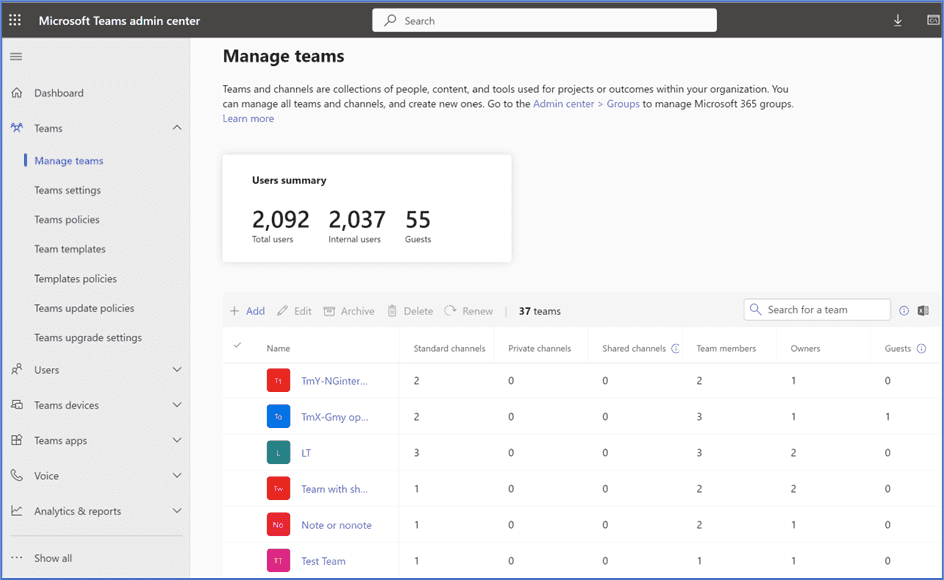Series
From chaos to control: mastering the art of orphaned teams cleanup and prevention
1: Introducing orphaned teams (you are reading this article)
2: Strategies for managing orphaned teams
Introducing orphaned teams
Microsoft Teams, a hub for teamwork within Microsoft 365, integrates people, content, and tools to enhance collaboration and productivity. Orphaned teams in this context refer to teams where the original owners have left the organization, moved onto other roles and are no longer managing the team, leaving it without clear leadership or oversight. This can lead to security risks, data governance issues, and operational inefficiencies.
The rise of orphaned teams
The rapid digital transformation and the shift towards remote work has led to a surge in collaboration tools usage. Microsoft Teams, being at the forefront, often sees a proliferation of teams created for various projects and departments. However, given the dynamic nature of modern work and without clear governance processes, teams can become 'orphaned'. This arises when the teams' original creators or owners have either left the organization, are no longer active due to license revocation, account deactivation or deletion in Microsoft Entra ID, or other technical errors and therefore can no longer manage the team, leading to potential risks and inefficiencies.
The role of team owners
Before we delve into the challenges posed by orphaned teams, it’s important to also understand the role owners play in a healthy Teams environment. In Microsoft Teams, team owners play a crucial role in managing and maintaining the team environment, ensuring that it is organized, secure, and productive. Their responsibilities include:
- Creating channels: team owners have the privilege to create new channels within Microsoft Teams, allowing for the organization of conversations, meetings, and file sharing based on projects, departments, or any other criteria that suit the organization's needs.
- Managing team members and permissions: owners are responsible for adding or removing members, managing guest access, and assigning roles within the team. They can designate other members as owners or members, thus controlling who has administrative capabilities versus who can only participate in conversations and access content.
- Configuring team settings: owners can modify team settings, including team name and description, privacy settings (private or public), and member permissions (like who can create channels or tabs). They can also manage integrations with other services and apps, enhancing the team's functionality and productivity.
- Moderating content and communication: to maintain a professional and respectful working environment, team owners can oversee conversations, moderate posts, and ensure that content shared within the team complies with organizational policies.
- Managing files and resources: owners oversee the files and resources shared within the team, including documents, notes, and apps. They can set up file permissions and ensure that sensitive information is appropriately protected.
With these responsibilities, it is important to always have owners overseeing a team. When a user creates a team in Microsoft Teams, a corresponding Microsoft 365 Group is created and the user is automatically added as the owner of that group (and team). Should this sole owner attempt to leave the team, they will first be directed to assign a new owner. However, as we discussed earlier, there are scenarios where this mechanism is ineffective towards preventing orphaned teams.
Challenges posed by orphaned teams
Team members typically go about their daily collaboration activities - chatting, conferencing, sharing and accessing documents, communicating in team channels. This is still possible, even when the team is orphaned, that is, when there are no owners assigned or active. Whilst they may seem harmless at first, orphaned teams pose several challenges to the organisation:
- Ownership and accountability: without designated owners, there is no one to manage membership, manage access controls, monitor activities, set policies for team activities such as calls, meetings and messages, or ensure compliance with company policies.
- Security risks: unmonitored teams may become repositories for sensitive information, vulnerable to unauthorized access.
- Data management: proper data governance becomes difficult, raising the risk of data loss or leakage.
- Operational inefficiency: orphaned teams can lead to redundancy, outdated information, and clutter, hampering productivity.
How to identify orphaned teams With the understanding of how undesirable it is to have orphaned teams, we need to find ways to identify such teams and address the ownership issue. One way to identify orphaned teams is through the Microsoft Teams admin center:
- Navigate to the Microsoft Teams admin center
- On the left menu, expand the "Teams" section,
- Navigate to "Manage teams"
From this view, you will have table that shows you a list of teams along with data on the number of owners, members, guests, channels, and other data. By default, the columns for owners and guests might be hidden, but you can use the Settings option in the top right-hand corner of the table to make these additional columns visible.
Orphaned teams will not have owners assigned and will display a “0⚠” in the ownenrs column. Other interesting scenarios that you can identify from this report include:
- Teams that do not have any members or guests. These teams might be unused and unnecessary.
- Teams that only have guests. These teams have external entities only, and these might not be aware of your organisation's policies and procedures.
Although this report is useful, it might only be practical to use when you have a relatively small number of teams in your organisation. Larger organisations will be interested in repeatable, automated approaches that also deal with thousands of teams. Whilst beyond the scope of this article, one can alternatively use the "Get-Team" and "Get-TeamUser" PowerShell cmdlets to identify teams that do not have owners.
What should I do with the orphaned teams?
Once you have identified the orphaned teams, you will want to identify ways to address the problem. In part 2 of this series, we will discuss different strategies and approaches for managing these orphaned teams, including the benefits you can get from our innovative governance solution, EasyLife 365 Collaboration.







